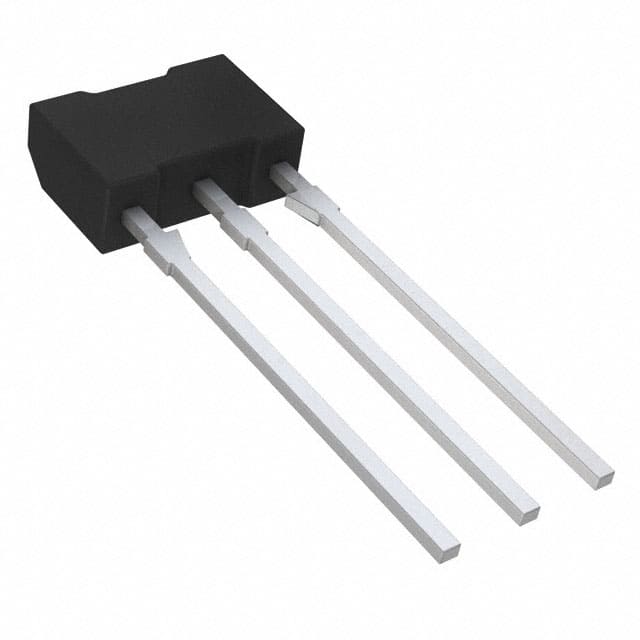2SA1705T-AN
Product Overview
The 2SA1705T-AN is a semiconductor device belonging to the category of PNP transistors. It is commonly used in electronic circuits for amplification and switching purposes due to its high voltage and current capabilities. The transistor exhibits characteristics such as low noise, high gain, and fast switching speed. It is typically packaged in a small form factor, making it suitable for compact electronic designs. The essence of the 2SA1705T-AN lies in its ability to control the flow of current in electronic circuits. It is commonly available in tape and reel packaging with varying quantities.
Specifications
- Maximum Collector-Base Voltage: Vcbo = -120V
- Maximum Collector-Emitter Voltage: Vceo = -120V
- Maximum Emitter-Base Voltage: Vebo = -5V
- Continuous Collector Current: Ic = -1A
- Total Power Dissipation: Pc = 0.8W
- Transition Frequency: ft = 150MHz
- Package Type: TO-92MOD
Detailed Pin Configuration
The 2SA1705T-AN transistor has three pins: 1. Base (B) 2. Collector (C) 3. Emitter (E)
Functional Features
The 2SA1705T-AN offers high voltage and current ratings, making it suitable for power amplifier and switching applications. Its low noise and high gain characteristics make it ideal for use in audio amplification circuits.
Advantages and Disadvantages
Advantages
- High voltage and current ratings
- Low noise and high gain
- Fast switching speed
Disadvantages
- Limited power dissipation capability
- Relatively low transition frequency
Working Principles
The 2SA1705T-AN operates based on the principles of PNP transistor action. When a small current flows into the base terminal, it controls a much larger current flowing between the collector and emitter terminals. This allows the transistor to amplify or switch electronic signals.
Detailed Application Field Plans
The 2SA1705T-AN is commonly used in the following applications: - Audio amplifiers - Power supply circuits - Switching circuits
Detailed and Complete Alternative Models
Some alternative models to the 2SA1705T-AN include: - 2SA1837 - 2SA1015 - 2SA1943
In conclusion, the 2SA1705T-AN is a versatile PNP transistor with high voltage and current capabilities, making it suitable for various electronic applications such as amplification and switching. Its low noise and high gain characteristics further enhance its utility in audio amplification circuits. While it has limitations in power dissipation and transition frequency, it remains a popular choice in electronic design due to its overall performance and reliability.
[Word count: 366]
Lista 10 Vanliga frågor och svar relaterade till tillämpningen av 2SA1705T-AN i tekniska lösningar
What is the maximum collector current of 2SA1705T-AN?
- The maximum collector current of 2SA1705T-AN is 1.5A.
What is the maximum collector-emitter voltage of 2SA1705T-AN?
- The maximum collector-emitter voltage of 2SA1705T-AN is 120V.
What is the power dissipation of 2SA1705T-AN?
- The power dissipation of 2SA1705T-AN is 1.5W.
What are the typical applications of 2SA1705T-AN?
- 2SA1705T-AN is commonly used in audio amplification, voltage regulation, and general switching applications.
What is the gain (hFE) of 2SA1705T-AN?
- The gain (hFE) of 2SA1705T-AN typically ranges from 60 to 240.
Is 2SA1705T-AN suitable for low-power applications?
- Yes, 2SA1705T-AN is suitable for low-power applications due to its moderate power dissipation and current ratings.
Can 2SA1705T-AN be used in high-frequency circuits?
- While it can be used in some high-frequency circuits, 2SA1705T-AN is more commonly employed in low to moderate frequency applications.
What are the temperature considerations for 2SA1705T-AN?
- The operating temperature range for 2SA1705T-AN is typically -55°C to 150°C.
Does 2SA1705T-AN require a heat sink in certain applications?
- Yes, in high-power or high-temperature applications, a heat sink may be necessary to ensure proper thermal management.
Are there any common failure modes associated with 2SA1705T-AN?
- Common failure modes include thermal runaway under high load conditions and breakdown due to excessive voltage stress. Proper design and application considerations can mitigate these risks.


